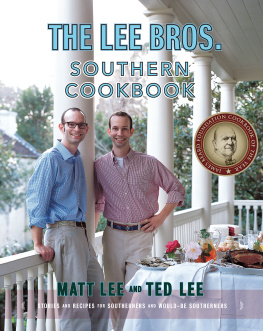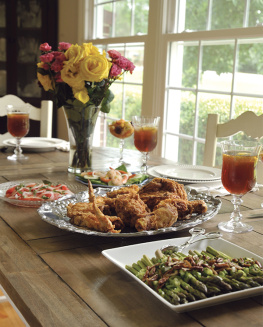
Copyright 2016 by Jasper Alexander
Photographs copyright 2016 by Heather Bohm-Tallman
All rights reserved
For information about permission to reproduce selections from this book, write to Permissions, The Countryman Press, 500 Fifth Avenue, New York, NY 10110
For information about special discounts for bulk purchases, please contact W. W. Norton Special Sales at specialsales@wwnorton.com or 800-233-4830
The Library of Congress has cataloged the printed edition as follows:
Names: Alexander, Jasper, author. | Bohm-Tallman, Heather, photographer.
Title: The Hatties Restaurant Cookbook : Classic Southern and Louisiana
Recipes / Jasper Alexander ; photography by Heather Bohm-Tallman.
Description: Woodstock, VT : Countryman Press, [2016] | Includes bibliographical references and index.
Identifiers: LCCN 2016013900 | ISBN 9781581573466 (hardcover)
Subjects: LCSH: Cooking, AmericanSouthern style. | Cooking,
AmericanLouisiana style. | CookingNew York (State)Saratoga Springs.
| Hatties Restaurant (Saratoga, N.Y.) | LCGFT: Cookbooks.
Classification: LCC TX715.2.S68 A38 2016 | DDC 641.5975dc23
LC record available at https://lccn.loc.gov/2016013900
ISBN 978-1-58157-558-3 (e-book)
The Countryman Press
www.countrymanpress.com
A division of W. W. Norton & Company, Inc.
500 Fifth Avenue, New York, NY 10110
www.wwnorton.com

This book is dedicated to Hattie Moseley Austin.


Photo by Michael L. Noonan
You want to do what? This was my reaction when my wife first proposed that we move to the East Coast and buy Hatties Chicken Shack. I thought she was delusional. We were both in the middle of successful careers in Seattle. We had just bought a house. We had an infant daughter. By all accounts, things were going as planned.
I was the chef of a well-respected Seattle restaurant and beginning to make a name for myself. She was booking private events for a swanky steakhouse and making great money. The Seattle food scene during the late nineties was exploding.

I had trained at the Culinary Institute of America, the most prestigious culinary school in the country. For four years after graduation, Id cooked in some of the finest kitchens in New York, working alongside some of the best chefs around, culinary titans. I had James Beard awards to win, an empire to build. How were any of these things going to be accomplished frying chicken in Saratoga Springs?
Besides, I was a West Coast kid. Both my immediate and extended family had Southern roots, but my parents had left Washington, D.C., my birthplace, before my fifth birthday and Id grown up in San Diego and Seattle.
I wasnt guilty of having a big-town prejudice. Actually I like small towns. I chose to go to college in Walla Walla, Washington, a town of about 30,000. And I had spent time in Saratoga and loved it. Six years earlier, I had met Beth there. In the spring of 1995, a fellow cook at Gramercy Tavern suggested I join him in spending the summer in Saratoga, working at Siros. We were both transitioning from New York back to the West Coast. He was headed to San Francisco and I was going to try my hand at being a ski bum in Sun Valley, Idaho, for the winter and then plan my next serious career move. Whats Siros? I asked. Summer camp for cookslots of booze and women and they pay a thousand bucks a week. Compared to stewing in the hot basement kitchens of New York for the summer, Saratoga sounded like heaven. So, I signed up, and Saratoga and Siros delivered as billed.
I had a great time that summer, lounging and chasing bikinis at historic Victoria Pool during the day and cooking great food at night in a restaurant that was far better than I expected. Siros was, at the time, a high-end seasonal restaurant that catered to those who fly themselves and their horses to Saratoga for the six-week meet at the Saratoga Race Course.
The most significant event of my summer was meeting Beth. She was a former professional ballet dancer who taught dance at a local arts school. As a native of the Saratoga area, she had worked at various local restaurants during summer breaks. That summer she was working at Siros.
In the fall, she went back to teaching and I went to Sun Valley as planned, but soon we were coordinating cross-country trips. It was during one of these trips that I was introduced to Hatties.
Beth was working there part time and sometimes I tagged along. Hatties was far from what I was used to, but it was obviously a special place. The room was dripping with atmosphere. Not atmosphere manufactured by a restaurant designer, but the kind you find only in restaurants that have been around a long timerestaurants that have cultural and historical significance. Passing through the front door at Hatties, it was easy to imagine being in a different time, surrounded by the collective memories of what had transpired there.
So, when Hatties was quietly put on the market in 1999, Beth and I began considering what Hatties already was and what it could be. We could freshen the menu, update the kitchen, really concentrate on the quality of what came out of it, and build on Hatties historical presence in Saratoga. We could introduce a lively catering component that would serve innovative high-end food with a Southern or Cajun influence. We could strengthen the restaurants ties to the community by sponsoring fund-raisers for local nonprofits, tying into its Southern theme.
That is what we have done in the 15 years we have owned Hatties. This book chronicles our path: what we inherited from Hatties iconic position in Saratoga and what we have created. The most tangible evidence of our business direction has been the opening of two new venues, the Track Shack, a seasonal concession at the Saratoga Race Course, and Hatties Chicken Shack, a year-round quick-service restaurant that is conceptually centered on our core menu.
We have respected the legacy of Hattie Moseley Austins generosity and nurturing spirit by staying actively engaged in community affairs and local philanthropic projects.
A major component of our community support is an annual Hatties Mardi Gras fund-raiser. Since 2001, we have raised more than $650,000 for selected charities based in Saratoga Springs. Weve also both served on the boards of a number of local nonprofit organizations related to the business community and local cultural and arts organizations. Our participation in local affairs keeps Hatties tied to its founders principles and to its mission as an institution.
Hatties Story
Hatties is a restaurant that has been serving Southern cuisine for 78 years in a decidedly northern location. It reflects the history of its community, beginning with the glittering spa and gambling scene that brought Hattie Moseley Austin to Saratoga.
Accounts differ on some of the details and dates of Hattie Moseley Austins history, but theres general agreement on the central story line. She was born Hattie Gray and was a native of Louisiana. She worked in the 1930s as a domestic cook for the A. E. Staleys, a Midwestern family that had made a fortune from processing cornstarch into household products. Hattie followed them regularly for many years from Chicago to Miami to Saratoga Springs, with occasional seasonal cooking at a few of Saratogas hotels. Then, in 1938, she decided to stay in Saratoga and open her own restaurant, Hatties Chicken Shack, which has evolved from a tiny storefront venture into an iconic, if unlikely, symbol of the community.
Next page












